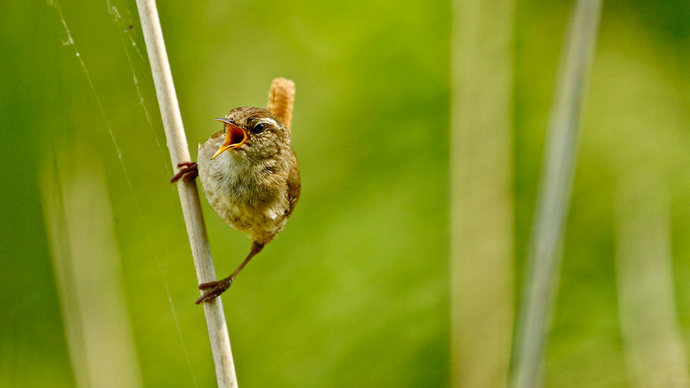Common name: wren
Scientific name: Troglodytes troglodytes
Family: Troglodytidae (wrens)
Habitat: woodland, heathland, farmland, gardens
Diet: insects, spiders
Predators: domestic cats, foxes
Origin: native
Plump, short and loud-mouthed, the wren is one of our most common breeding birds. Though it’s small in size, it makes up for it with its powerful song.
Common name: wren
Scientific name: Troglodytes troglodytes
Family: Troglodytidae (wrens)
Habitat: woodland, heathland, farmland, gardens
Diet: insects, spiders
Predators: domestic cats, foxes
Origin: native
Wrens are small, short birds, measuring just 6-10cm in length. They are brown in colour, with paler underparts and darker wings. They have plump bodies, a blunt, cocked tail and a sharp, pointy bill.
Wrens usually eat close to the ground, using their pointed bill to snack on insects, spiders and other small morsels. They also eat seeds, berries and even tadpoles.
The Eurasian wren is the only species of this bird family found outside America.
The breeding season for wrens takes place during early spring, with males establishing their territories during this time. Each male uses moss and twigs to build a selection of domed nests for females to consider when they enter the male’s territory. If a female chooses a certain male’s nest, they will begin breeding once the nest has been lined. Nests are usually built in sheltered areas, including in nest boxes.
Usually around 5-7 eggs are laid, hatching after approximately two weeks. Both parents feed the young, which will fledge a further 15-20 days later. Second broods are common, and males often mate with more than one female.

Credit: Tony Cox / WTML
Wrens can be found in deciduous and mixed woodland, farmland, heathland and gardens across the UK.
Folklore tells how the wren became the king of birds by riding on the back of an eagle – it was said the bird who flew highest would take the crown.
More often heard than seen, your best chance of identifying this little bird is by listening out for its loud song. For such a small bird, it has an incredibly powerful voice!
These birds are common in the UK, however cold weather is a big threat to wren numbers; these birds do not cope well in low temperatures. Numbers often fall significantly in winter, due to both the freezing temperatures and the lack of insect prey available.
Keep exploring